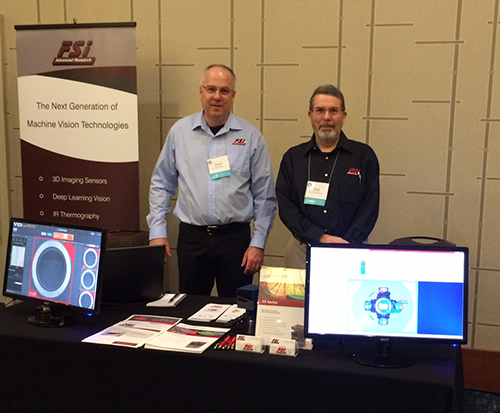 FSI Advanced Research exhibited at the South Carolina Automotive Summit held at the Hyatt Regency, Greenville, February 25-26, 2106, as part of the SC Auto Week.
FSI Advanced Research exhibited at the South Carolina Automotive Summit held at the Hyatt Regency, Greenville, February 25-26, 2106, as part of the SC Auto Week.
Category Archives: Newsletter
What is a Machine Vision ArchitectSM?

A Machine Vision ArchitectSM will consider your functional needs, your budget, and restrictions of your site, while applying engineering, lighting, and optic principles, and the latest imaging technologies to design a solution for you.
An architect will bring you an independent and fresh look at your needs and suggest creative ways of meeting those needs. He or she will be able to save you time, money, and navigate around typical vision pitfalls
A building architect uses a “blueprint” to record the design plan and other technical aspects of what the finished product should be. In similar fashion, FSI Machine Vision ArchitectsSM use the VAS (Vision Application Specification) form to record all the technical aspects of the application and the desired outcome. This form is the blueprint that is used to build and engineer the final solution.
Successful projects result from clients and architects who form good professional relationships early in the design process, and are nourished by clear communication, mutually understood expectations, and a willingness of both client and architect to understand and accept their responsibilities for realizing a successful project.
A successful project is one that responds to your needs, built on time, within budget, and contributes to the quality of your products, services and/or company.
Let FSI be your Machine Vision ArchitectSM and work with you toward an Assured Path to Success TM.
Track & Trace for the Pharmaceutical Industry
 EVT presents the new Track and Trace image processing system for the pharmaceutical industry. EyeTrace was developed to prevent forged pharmaceutical products from entering the supply chain and assures the traceability of the drugs.
EVT presents the new Track and Trace image processing system for the pharmaceutical industry. EyeTrace was developed to prevent forged pharmaceutical products from entering the supply chain and assures the traceability of the drugs.
EyeTrace, using an industrial camera and EyeVision image processing software, can detect more than the human eye. EyeTrace makes the inspection of security features on the packaging easier and can identify every single package.

Eye Vision can also read codes: bar code, QR, or DMC. With the code reader function, EyeTrace can read:
- Code of the drug maker
- serial number
- A national number for the reimbursement of costs
- Charge number
- Expiration date
Besides the code reader function, EyeTrace can be extended with other commands within the EyeVision software tool set.
EyeCheck Thermo in New Housing
 The first intelligent thermal imaging camera – EyeCheck Thermo from EVT – is now available with protection class IP65 or IP67, making it optimally suited for industrial use.
The first intelligent thermal imaging camera – EyeCheck Thermo from EVT – is now available with protection class IP65 or IP67, making it optimally suited for industrial use.
Inside the compact housing is a user programmable FPGA. The integrated ZYNQ board is available for application programming. It is also possible to use different ZYNQ boards, corresponding to the needs of the application.
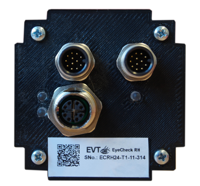 The EyeCheck Thermo has eight 24v inputs and eight 24v outputs. By using the additional thermal command set, complex applications for the thermal imaging area can be solved quite easily via drag-and-drop-programming.
The EyeCheck Thermo has eight 24v inputs and eight 24v outputs. By using the additional thermal command set, complex applications for the thermal imaging area can be solved quite easily via drag-and-drop-programming.
Detecting Packaging Flaws with EyeVision
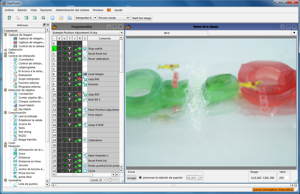 To present food neat and appealing for the customer, flawless packaging is very important. The wrapping is not only to protect the product during transport; packaging also is important in the placement of the product on supermarket shelves.
To present food neat and appealing for the customer, flawless packaging is very important. The wrapping is not only to protect the product during transport; packaging also is important in the placement of the product on supermarket shelves.
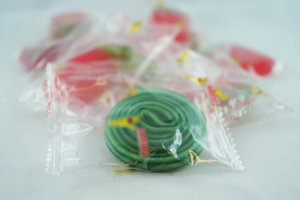 In one current application, EVT’s EyeCheck 1xxx series was used to inspect bags of separately wrapped candies to make sure that they did not slip into the heat-sealed ends of the bag. With the drag-and-drop functionality of the software, the customer can easily create their own inspection program without programming skills. Additionally, the user can add color inspection commands to the software and then the candies can also be inspected for the correct colors.
In one current application, EVT’s EyeCheck 1xxx series was used to inspect bags of separately wrapped candies to make sure that they did not slip into the heat-sealed ends of the bag. With the drag-and-drop functionality of the software, the customer can easily create their own inspection program without programming skills. Additionally, the user can add color inspection commands to the software and then the candies can also be inspected for the correct colors.
EyeSens with OPC Support
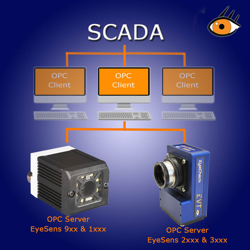 The EyeSens systems from EVT can now also serve as an OPC (Open Platform Communications) server. The OPC standard allows the EyeSens sensors and the EyeVision software to function as OPC server. Detected data such as measured values are now easily sent to a client. The user can determine which data should be sent to the OPC client using the standard interfaces, RS232 or Ethernet. As with other EyeVision software operations, the OPC integration is possible with the drag-and-drop function.
The EyeSens systems from EVT can now also serve as an OPC (Open Platform Communications) server. The OPC standard allows the EyeSens sensors and the EyeVision software to function as OPC server. Detected data such as measured values are now easily sent to a client. The user can determine which data should be sent to the OPC client using the standard interfaces, RS232 or Ethernet. As with other EyeVision software operations, the OPC integration is possible with the drag-and-drop function.
An example would be the EyeSens Bottle Inspect (BI) measures the fill level and sends this data via OPC to the SCADA (Supervisory Control And Data Acquisition) system. Based on this measured data the SCADA system can regulate the fill level and also display the data graphically.
Particle Inspection on Semiconductor Wafers using EyeVision Software from EVT

EyeVision Machine Vision software has developed a program for wafer particle inspection, especially for the semiconductor industry.
Particles are probably the most common defects in wafer production. During transport, during processing, or even in the plant itself, particles such as dust or material abrasion can settle on the wafer. This can develop into an undesirable covering and alter the processing in this area.
The particles can prevent the etching or the precipitation of layers. This can lead to malfunctions such as short-circuits or missing electrical joints between conductors. The particle inspector of EVT software analyzes the surface of the wafer for dust and other particles, using a laser line.
EyeVision software recognizes even the slightest discrepancy and can send an evaluation of the wafer as Good or Bad. EyeVision software is very easy-to-handle and the particle inspection module can be adjusted easily in the graphical user interface.
Using EyeVision to Recognize Flux on Solar Cells
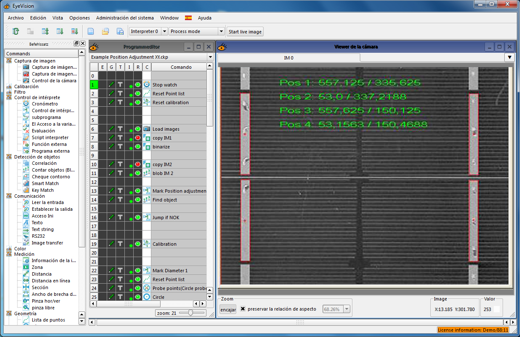
A reliable, accurate application of connecting materials such as flux, soldering paste or conductive adhesive is crucial to solar cell production.
EVT has developed a program which checks the application of flux. First, the software checks the presence of flux on the conduction bands, to verify if the flux has been applied. Additionally, EyeVision software program controls the admission of flux directly before soldering, which is especially important with mixed printed board assemblies.
The EyeVision inspection system optimizes the connection of solar cells and the construction of solar strings.
EyeVision software is easy to use. The programming is done in the graphical user interface with the drag-and-drop function. This means that for creating an inspection program no special programming skills are required. The commands are ready-made and the user has only to drag an icon from the Toolbox into the Program editor.
ThermoCam LC – Thermal Imaging Sensor by EVT
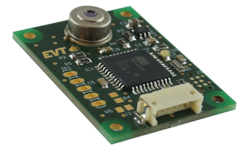 The ThermoCam LC was developed by EVT (EyeVision Technology) to provide low cost infrared solutions for the machine vision industry, and uses the thermographic command set of EyeVision software.
The ThermoCam LC was developed by EVT (EyeVision Technology) to provide low cost infrared solutions for the machine vision industry, and uses the thermographic command set of EyeVision software.
The TCLC allows an image capture of up to 100 images per second and is delivered already calibrated. The noise (NETD) is only 0.2K, which guarantees thermal images with high resolution. This means that the TCLC camera can work in conditions where a less sensitive camera might miss defects such as scratches and other flaws. Also, a reduced noise means that it is easier to focus the camera and to identify objects in the IR-image.
The ThermoCam works in a temperature range of -50°C to +300°C, with a field of view of 32×8 pixels, and optional opening angle of 40°, 60° or 120°.
The TCLC is suitable for applications such as detecting hot parts on a circuit board; delivering distant temperature measurements in critical processes; and measuring the temperature gradation on surfaces.
For example, the camera made it possible to distinguish different materials such as synthetic leather from real leather; to detect structural interruptions in fiber composites; and to measure the layer thickness of lacquer.
BrainLight QC – Back Light
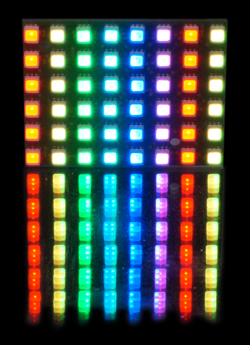 EVT (EyeVision Technology) introduces the newest back light of the BrainLight smart illumination series. The BrainLight QC for industrial use can be adjusted to almost any machine vision application.
EVT (EyeVision Technology) introduces the newest back light of the BrainLight smart illumination series. The BrainLight QC for industrial use can be adjusted to almost any machine vision application.
The LEDs of the intelligent back light can illuminate in red, green, blue and white. There is a diffusor plate in front of the LEDs, so that the light spreads evenly over the object. There are 48 full-color LEDs, which are arranged in a tight grid.
The user can choose any of the four available colors, and the LEDs can be switched on row by row. Light sequences can be programmed and played successively. The light can be dimmed, or work in complete brightness; even a flash mode is possible.
The BrainLight QC is 30 x 40 mm in size and has an input voltage of +24V. It is modularly expansible; LED rows can be added, depending on the application. Additionally, the QC back light has highly efficient switches, which guarantee minimal heat development.
